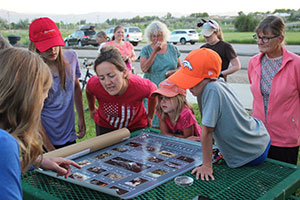UW’s Biodiversity Institute to Host Summer Bat Walk in Sheridan June 29
Published June 02, 2023

Sheridan will be going a little bit batty this summer. At least for one evening.
The University of Wyoming Biodiversity Institute will host a free Summer Bat Walk in Sheridan Thursday, June 29, from 8:30-10 p.m. in the South Park open space. The bat walk is capped at 20 participants.
“Bat walks are special because they allow people to get acquainted with an often-misunderstood nocturnal animal,” says Mason Lee, a senior project coordinator of the Biodiversity Institute who leads the walks. “Participants on bat walks learn about how vital bats are to our world; what they can find in Wyoming; and then they get the chance to actually see and hear these animals in action. We often witness bats foraging or swooping by water for a drink on the bat walks.”
Bats are invaluable to Wyoming and to ecosystems around the world. All bats in Wyoming -- of which there are 18 species -- are insectivores, and they eat a lot of crop pests. It is estimated that, in the U.S., bats save farmers $3 billion each year in pest control, Lee says. Insectivorous bats help protect crops such as corn, cotton, potatoes and wheat.
“There are about nine bat species that are likely to be found in Sheridan, out of Wyoming’s 18 species,” says Lee, who is a certified Bat Walk Ambassador through Bat Conservation International (BCI). “Last year, we saw and heard four species -- little brown myotis, big brown bat, silver-haired bat and hoary bat -- on the Sheridan Bat Walk.”
BCI is an international, nongovernmental organization working to conserve the world’s bats and their habitats through conservation, research and education efforts. The Biodiversity Institute is the only certified Bat Walk Ambassador to offer this program in Wyoming. Bat walks are designed to introduce communities to the amazing and beneficial flying mammals that live in their area.
Most bats echolocate at a frequency that is too high for human ears. But a device, known as an Echo Meter Touch, that Lee takes on the walks “translates” their calls to a lower frequency that can be heard by people.
“The device allows us to identify what species of bat is calling, so we can often put a name to the bat as it flies and calls around us,” Lee explains. “Without this device, we wouldn’t be able to hear bats calling as they fly around, since they echolocate at frequencies much higher than humans can hear. And, without the device, we might know it’s a bat flying around, but we’d have no way to tell which species it is. The device allows us to glimpse the bat biodiversity in our local area.”
Bats also have chatter or social calls, which they emit when they’re in a bat box, which are artificial roosts. These chatter or social calls are at lower frequencies, which humans can sometimes hear, Lee says.
For a recording of bats during a previous bat walk, go to https://vimeo.com/717518476.
“I hope people who attend the bat walks leave with a deep appreciation for these incredible animals,” Lee says. “I hope they talk with their friends and families about how amazing bats are and share some of their favorite bat facts that they learn so that others will develop an interest in conserving bat biodiversity.”
For more information about Summer Bat Walks, go to https://mail.wyomingbiodiversity.org/index.php/outreach/bat-walks.
The UW Biodiversity Institute fosters conservation of biodiversity through scientific discovery, creative dissemination, education and public engagement. In this setting, scientists, citizens, students and educators come together to share a wealth of perspectives on the study and appreciation of biodiversity -- from microbes to poetry and ecosystems to economics. Learn more at www.wyomingbiodiversity.org.

